Rob Wolf's Blog, page 17
February 20, 2016
Brenda Cooper: PKD Nominee Grapples with Transhumanism
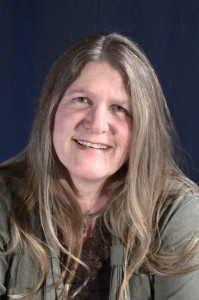
My interview with author and futurist Brenda Cooper is the second of my conversations with nominees for the 2016 Philip K. Dick Award.
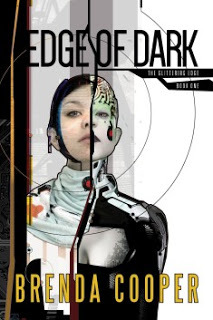 Cooper�s novel Edge of Dark (Pyr, 2015) is set in a solar system where human are forced to confront a civilization they�d lone ago banished: a race of super-beings who evolved from humans into cyborgs.
Cooper�s novel Edge of Dark (Pyr, 2015) is set in a solar system where human are forced to confront a civilization they�d lone ago banished: a race of super-beings who evolved from humans into cyborgs.The idea of implanting human intelligence into an artificial body is not new. But Cooper gives it a fresh twist by making the ethics of human-robot blending the central theme of her book. The super-beings (called variously ice pirates and the Next) are returning uninvited from their banishment and, in addition to seeking access to natural resources, are offering immortality to anyone who wants it.
Cooper sees Edge of Dark as part of a conversation about the evolution of the human race. "I�m fascinated by transhumanism what we�re going to become," Cooper says. "I do think that we�re becoming something different� I�m exploring what the human soul might be about."
All six PDK-nominated authors participated in a joint podcast where they interview each other. It�s available here.
Published on February 20, 2016 21:00
February 6, 2016
Podcast: Interview with Douglas Lain
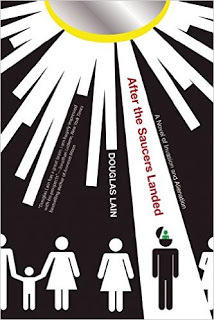
I'm planning to interview on New Books in Science Fiction all six nominees for this year's Philip K. Dick Award. First up is Douglas Lain, whose (Night Shade Books, 2015) is set in the early 1990s, when aliens, with the theatrical sense of B-movie directors, land flying saucers on the White House lawn.
At first, the visitors seem fit for a Las Vegas chorus line; they're tall, attractive and never leave their spaceships without donning sequined jumpsuits. Even the name of their leader�Ralph Reality�is marquee-ready.
But is Reality as real as he seems?

That's the question that Lain poses for readers and his first-person narrator, Brian Johnson, who confronts the alien invasion head-on when one of the interstellar travelers assumes the identity of his wife. This propels Johnson into an examination of reality through various prisms: popular culture, science, philosophy, art, and even fiction.
A kaleidoscope of personalities, artists and thinkers are name-checked as Johnson and his colleagues search for the ultimate truth. There are as many nods to mainstream culture (think Elvis Presley, Arsenio Hall and David Letterman) as there are to high-brow (e.g., Ren� Magritte, Marcel Duchamp and Jean Baudrillard). And topping it off are the writings of ufologists, including the work of one of the characters, Harold Flint, who is so disappointed by the aliens' tackiness that he decides to stop studying UFOs altogether.
"The big challenge is try and take sometimes abstract ideas and philosophical concepts and bring them to life in the story while not losing any of their complexity," Lain says. Far easier, he found, was conveying the narrator's sense of unease and growing paranoia as he learns more about the aliens. "I've spent far too much of my life in that kind of state, so it comes naturally me to write about that feeling."
Published on February 06, 2016 21:00
January 22, 2016
Blizzard of 2016
I took these photos before 1 p.m. today, when the storm was only getting started.
#42ndstreet blanketed by blizzard. #blizzard2016 #snowmageddon #firstblizzard #snowstorm #n'oreaster2016 #❄️
A photo posted by Rob Wolf (@robwolfbooks) on Jan 23, 2016 at 9:25am PST
Remember the sun tan lotion Sea & Ski? This is Swim & Snow. #workingout #blizzard2016 #snowmageddon #n'oreaster2016 #firstblizzard #❄️
A photo posted by Rob Wolf (@robwolfbooks) on Jan 23, 2016 at 9:02am PST
Subway stairs never looked so pretty. #unionsquare #subway #snowmageddon #blizzard #storm2016 #❄️
A photo posted by Rob Wolf (@robwolfbooks) on Jan 23, 2016 at 6:41am PST
Published on January 22, 2016 21:00
January 7, 2016
My Tweet on the Front Page of the New York Times


I captured this image on June 25, 2015 to memorialize the moment when one of my Tweets scrolled across the front page of www.nytimes.com. It was exciting in the moment but oh so fleeting.
Published on January 07, 2016 21:00
January 6, 2016
Judith S. Kaye (1938-2016)
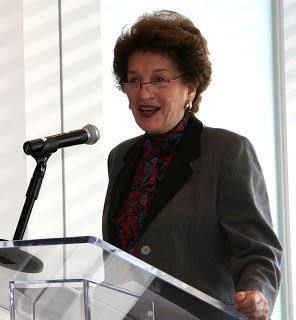
Judith S. Kaye, the first female chief judge and the longest serving chief judge of the New York State Court System, died today. She played an instrumental role in founding the Center for Court Innovation, where I have been privileged to work as a writer and editor promoting justice reforms, and she was an outspoken leader in making courts more creative, user-friendly and effective. I interviewed her a number of times, including for this article, which appeared in The Judges' Journal in 2002, and for a video about the Center. Excerpts of the video are available here.
Published on January 06, 2016 21:00
January 4, 2016
Podcast: Interview with David B. Coe>
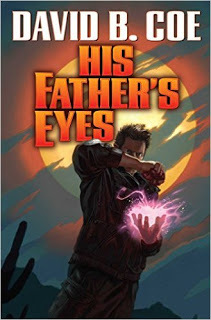
David B. Coe just finished a busy year in which he published three novels, two of which we discuss in this episode of New Books in Science Fiction and Fantasy.
His Father's Eyes (Baen, 2015) is the second book (the first, Spell Blind, was also published in 2015) to follow the adventures of P.I. Justis Fearsson, a weremyste whose investigations are interrupted once a month during the full moon when he slips into psychosis. Dead Man's Reach (Tor, 2015) written under the pen name D.B. Jackson, is the fourth book in the The Thieftaker Chronicles and focuses on Ethan Kaille, an 18th century version of a private detective (known poetically as a thieftaker) who also happens to be a conjurer.
While both protagonists share a number of traits (they're both crime-solvers and both have magic powers) the series are quite different.
The Thieftaker books are partly historical novel, ones in which Coe (aka Jackson) interweaves real people (e.g., Samuel Adams) and events of pre-Revolutionary Boston (e.g., the Stamp Act Riots, the Boston Massacre) with mysteries that Kaille is trying to solve.
"I spend an enormous amount of time searching for these tiny historical details to bring the verisimilitude to my story," Coe says.
Kaille's opponents (who include those who would like Kaille to meet the same end as the alleged witches of Salem) are external. But the eponymous protagonist of Coe's Case Files of Justis Fearsson series faces an internal enemy: the monthly psychosis that accompanies the full moon. These episodes are gradually making Fearsson permanently insane, as they did his weremyste father.
Related link:
Here is a blog post in which Coe interviews his two protagonists from the separate series, Justis Fearsson and Ethan Kaille.
Published on January 04, 2016 21:00
December 11, 2015
Teenagers plan a video
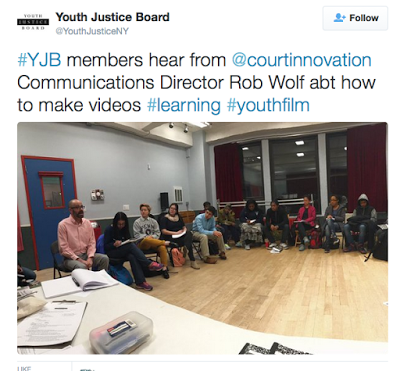
I spoke to members of the Youth Justice Board this week about how to make a video. The board is a teen leadership program that teaches New York City high school students how to analyze policies that affect teens and do something about them. They tackle subjects like truancy, kids in foster care, school safety, and kids and crime. This year's group is planning on making a training video for police officers that provides youth perspectives on cop-teen interactions, and they asked me questions about the videos I've directed and edited. Before I spoke, they placed me in the "hot seat"-- a chair at the front of the room where they asked me rapid-fire yes-no questions for seven minutes: Have you been to Europe? Have you ever gone hiking? Do you eat shrimp? Do you know anyone famous? Do you have kids? And then they asked great questions about how to make a video--so great, that I didn't always have the answers. I'll be helping them now and then, especially toward the end during the editing. If their thoughtful questions are any indication, I'm sure they'll come up with wonderful footage to work with.
Published on December 11, 2015 21:00
November 21, 2015
Carol


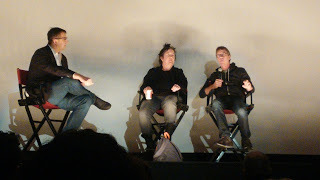
Todd Haynes, director, (on right in the middle photo) and Christine Vachon, in a question-and-answer session about their film Carol at the Paris Theater. Afterward, they went outside and snapped a photo of the marquee. I love how even totally amazing and accomplished filmmakers don't take the wonder of their accomplishments (as evidenced by the beautifully understated, class Paris marquee) for granted.
Published on November 21, 2015 21:00
November 8, 2015
Sarah Monette, The Goblin Emperor, and the French Revolution
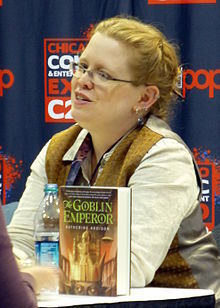
Katherine Addison's The Goblin Emperor has earned what might be termed a fantasy Grand Slam: the Locus Award for Best Fantasy Novel and nominations for the Nebula, Hugo and World Fantasy awards.
To make her achievement even more noteworthy, Addison, like Maia, the royal goblin at the heart of the book, is herself a fiction.
The pseudonym was created by author Sarah Monette to satisfy the demands of the publishing industry. As she explains to me in our conversation on New Books in Science Fiction and Fantasy, her real name had become a "deal-breaker" after sales of the four books of her Doctrine of Labyrinths series had fallen short of expectations.
Tor Books was eager to buy her tale of an innocent and virtually forgotten heir who ascends to the throne of the Elflands after the simultaneous deaths of his father and brothers, but they had one condition. "Tor said, 'We really want to take you on. We're very enthusiastic and excited, but we can't do it under your real name. You have to pick a pseudonym.' And I wanted to continue having a publishing career. So I picked a pseudonym."
While the name change might have given Monette a clean slate of sorts, it's clear to me that The Goblin Emperor's success relies largely on her prodigious skills as a storyteller. But Monette modestly speculates that something else might also be at play--that people may also be drawn to an ingredient that is rare in fantasy: idealism.
"So much of fantasy right now has been so influenced by George R.R. Martin--which, hey, that's excellent as it should be--but it does mean that things have been very grim and bleak and pessimistic and cynical," she says. In contrast, The Goblin Emperor "is arguing that doing the right thing will win; that is, if you try your best to be ethical and compassionate, you will come out on top."
There's no question that Maia's insistence on behaving ethically is refreshing. He faces down cronyism, social inequality and racism by hewing to the values of his Goblin mother, which lead him, among other things, to regard his subjects as equals.
"I wish I could say that I believed that worked all the time in the real world, but I think if we don't make up stories where it does work, it's never going to work," Monette says.
In fact, it was the real world that inspired Monette to create an enlightened emperor. �What I was doing was actually was trying to figure out if there was a way out of the French Revolution without the guillotine and Terror and all the really horrific horrific things that happened.� In other words, if Louis XV been more like Maia, could the French have achieved libert�, �galit�, fraternit� without so much bloodshed?
Not only do I find Maia refreshing, but I also find it refreshing that The Goblin Emperor is a stand-alone (this coming from someone who wrote a two-part series). Rest assured, however, that while Monette has no plans to revisit Maia, she remains loyal to the speculative genres.
"All fiction is lies but science fiction, fantasy and horror sort of flag themselves and say 'Hey--not true. This isn't what the real world is like.' ... The combination of the realistic and the openly unreal is to me something that is endlessly fascinating and that I want to do when I write and I enjoy reading when I find it."
Published on November 08, 2015 21:00
October 22, 2015
Smoking, No Smoking, Smoking, No Smoking

Not that long ago, the idea of outdoor "no smoking" zones seemed silly. But when many cities (including New York) banned indoor smoking, smokers began clustering at building entrances, generating tobacco clouds and butt piles. In other words, the indoor bans only moved the problem of second-hand smoke outside. The solution outside many buildings has been to post no smoking signs, like the one above. And while it seems to have forced many smokers to find another perch, or least get a little more exercise before enjoying a puff, the signs clearly don't always work.
Published on October 22, 2015 21:00



